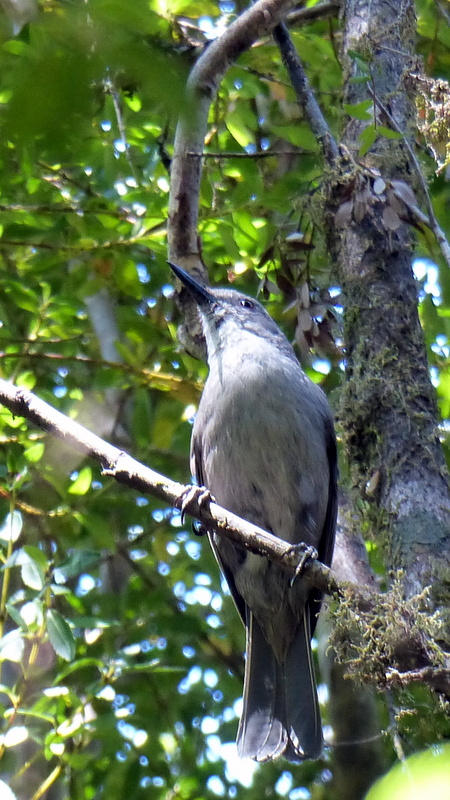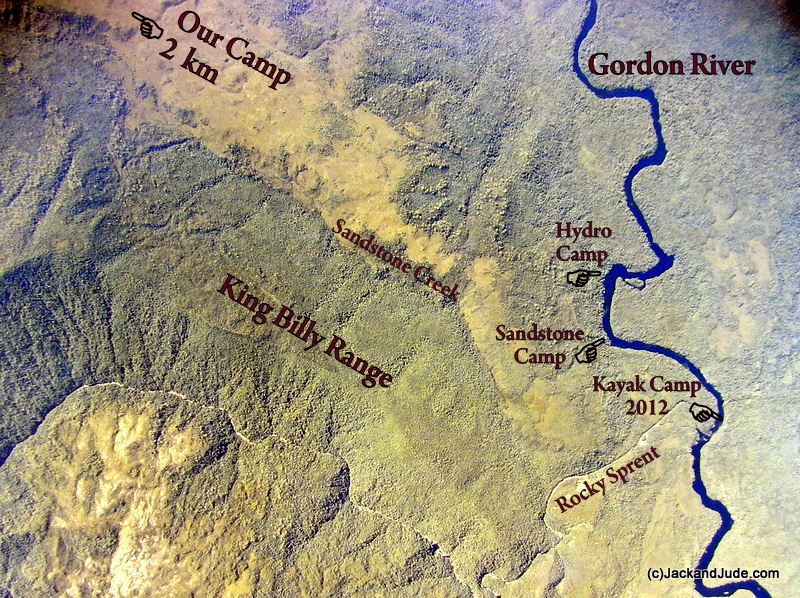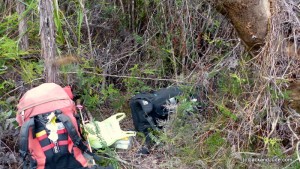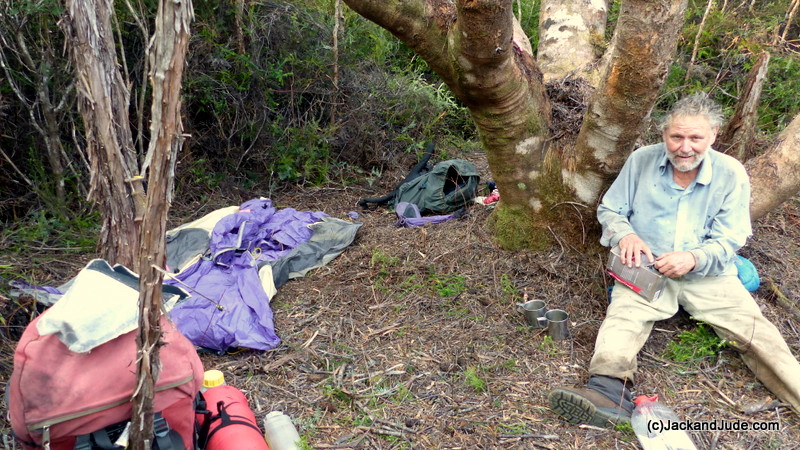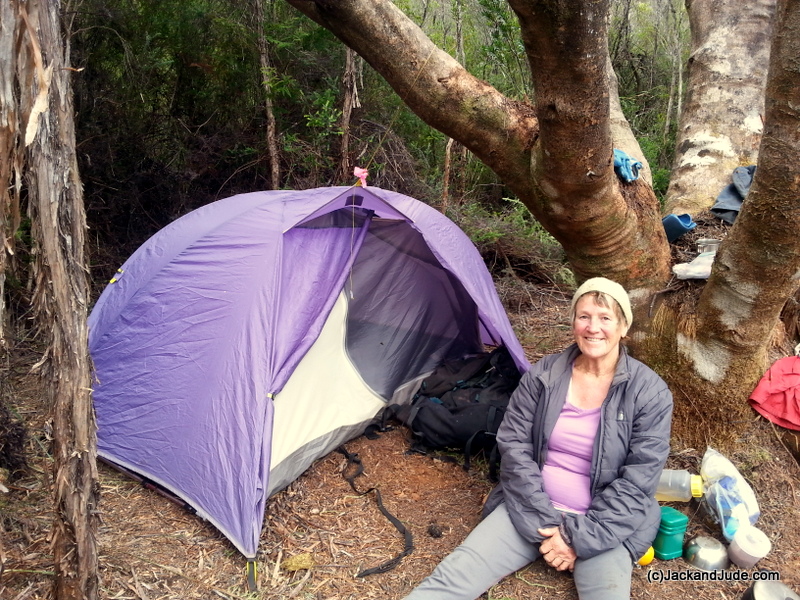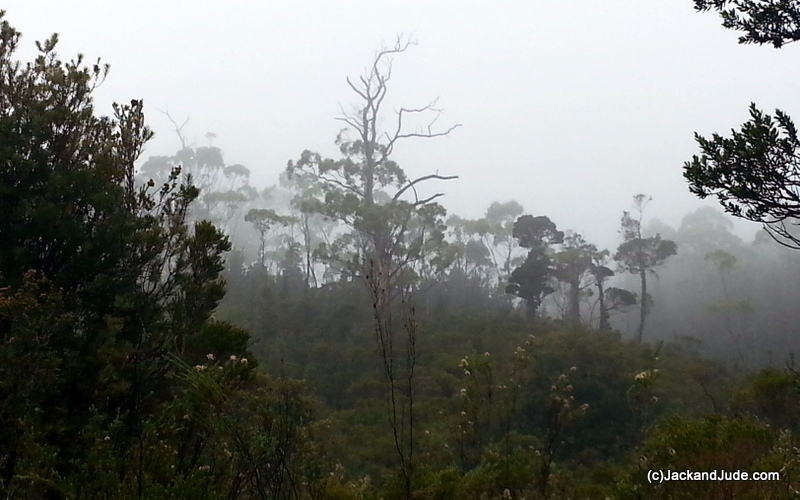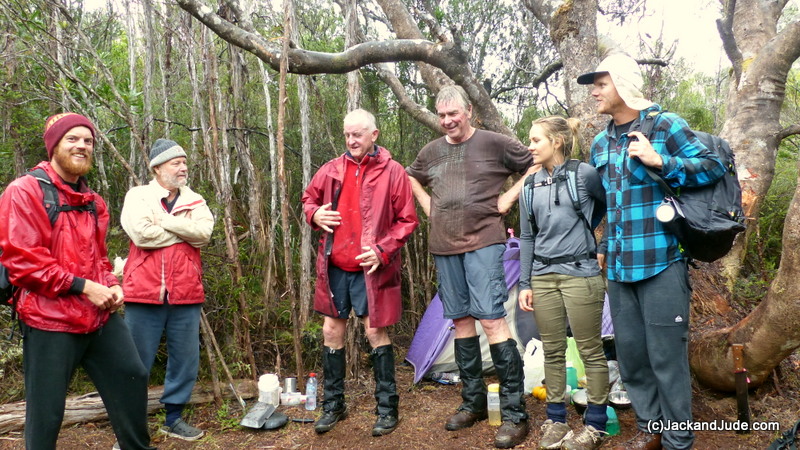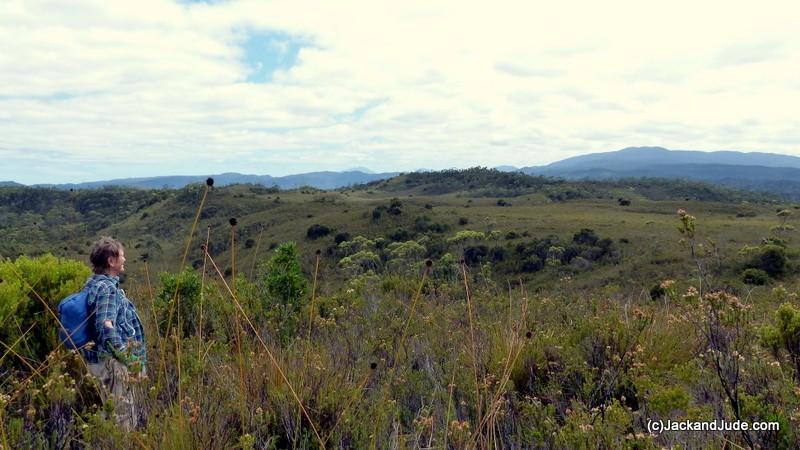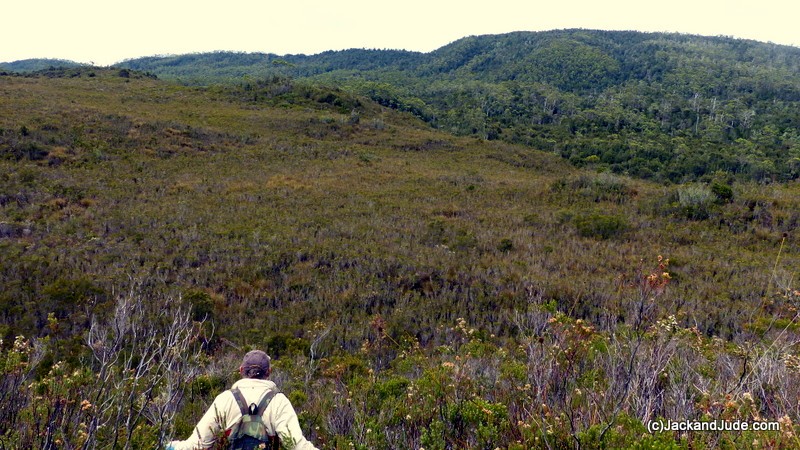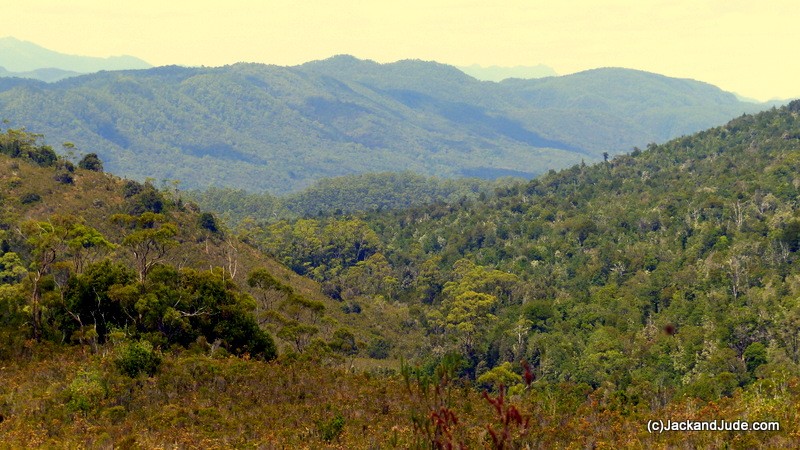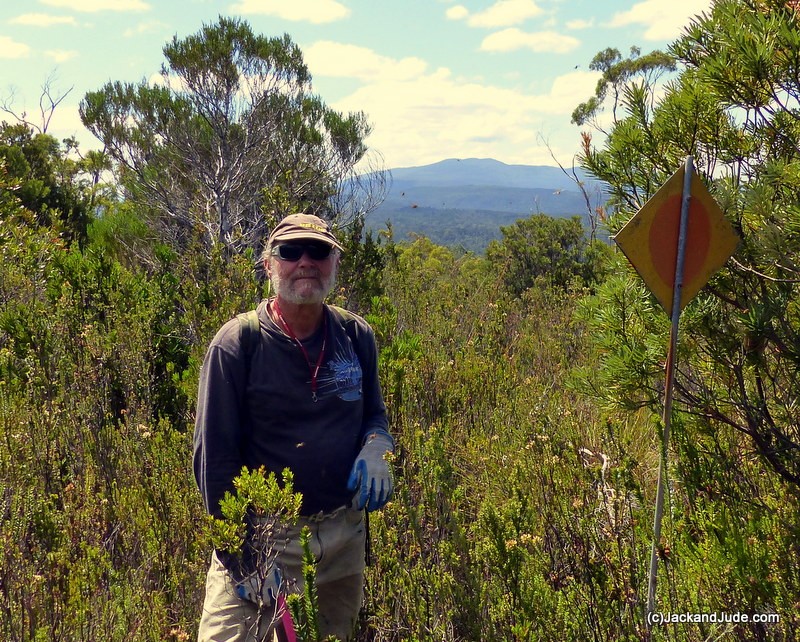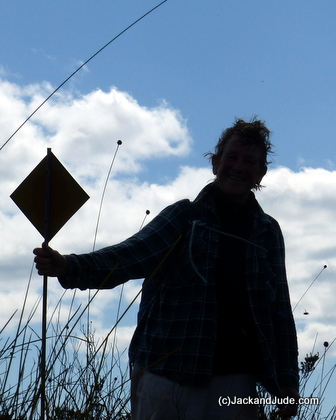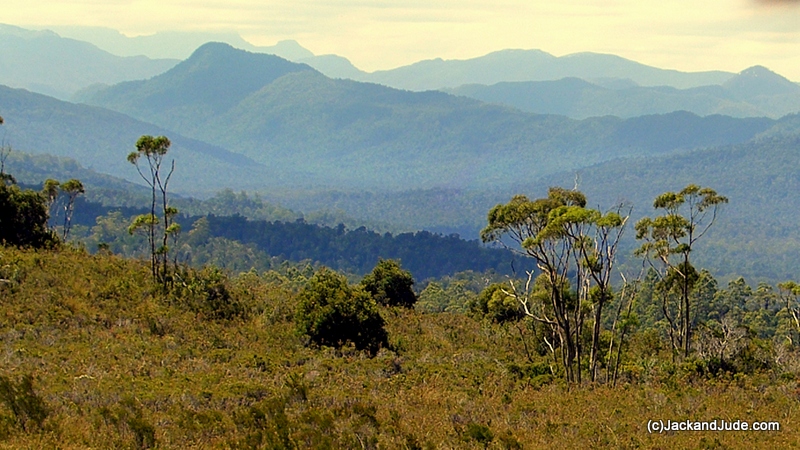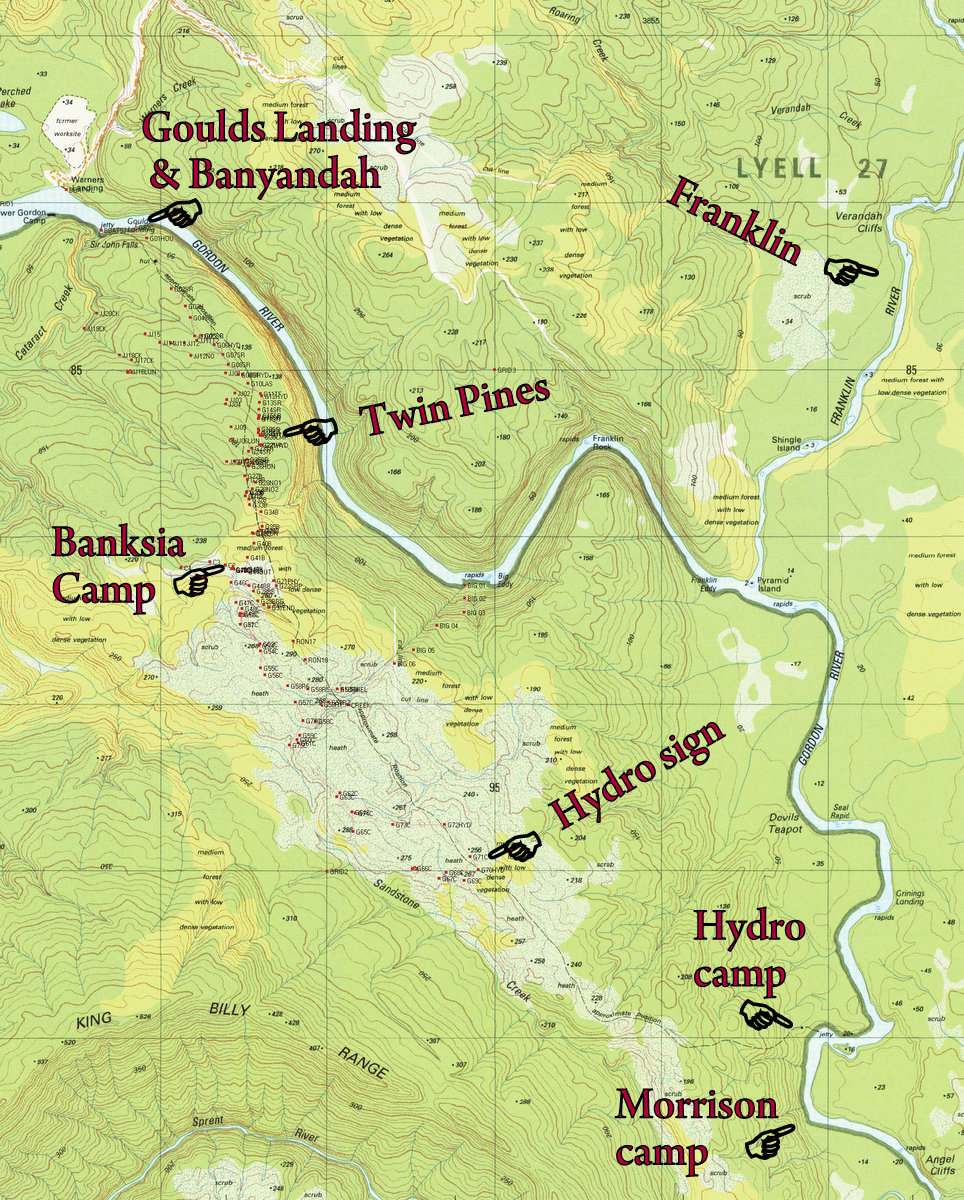A Walk in a Park ~ January 2016
Banyandah endured a windy, wet winter tied to our mooring near Strahan while up in northern NSW we enjoyed being with family and playing with our grandkids.
Probably nothing more would have come of our exploring the Goulds track if we hadn’t on a whim decided to see how our handy work had survived the winter. To our disbelief and dismay, we got lost the first time back after the winter break. Geez, a path we’d walked so many times led to a dead end. But a search of the area turned up a new Hydro sign, one not seen before. It was on a bit of shoe road not travelled on either. A few metres down it revealed one of our pink tapes and showed how we had come to be on it via a diversion around a massive tree fall. After that, an easy walk in a park to Camp Twin Pines. Not wanting to leave behind misleading tapes we then spent part of that day scouring the hills for unwanted ones, leaving behind an obvious route, so easy to follow that we continued through the Manuka forest, clearing up a few unwanted ribbons there also. Then went on to the headless Eucalyptus, which had survived the winter. Continuing ahead, the tunnel through the Bauera had closed somewhat but was reasonably passable up to the open buttongrass basin.
Finding the passage to the buttongrass basin still open must have been the trigger for a new plan. Because later that day when back on Banyandah, we simply gushed on taking our tent into that basin to continue our quest to reach the vast plain lying over the last ridge where we imagined finding remnants of the Hydro track. We envisaged walking unhampered under the mighty King Billy Range, and couldn’t get out our heads the possibility of actually retracing the entire route to the old Hydro camp on the Gordon, which we had visited a few years earlier by kayak.
Tasmania’s winter and autumn had been the driest on record, so the forest floor was crunchy dry – scary dry in fact when thoughts of lightening strikes entered our heads. It might have been a pleasure not to have droplets drip down our necks nor have slippery slime on our pant bottoms, but nor did we find a source of drinking water. At Camp Twin Pines, our three water sources found last year were dry sand. There were no colourful mushroom carpets, and the trees looked stressed. We hadn’t checked at the buttongrass basin but thought there might be a flow from the streams that drain part of the King Billy Range and form the headwaters of Cataract Creek. It was worth the chance, so we packed up our kit bags for at least a week in the bush.
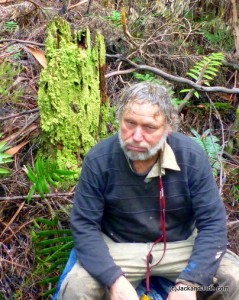 Carting twenty kilos on our backs along a path that degenerated from a walk to a crawl over fallen trees and through tangled Bauera tested our aging bodies. Amazingly we managed the outbound journey in about four hours, consuming half of the four litres of water we carried. Of course, we brought other liquids. Can’t go bush without a libation to celebrate surviving each day.
Carting twenty kilos on our backs along a path that degenerated from a walk to a crawl over fallen trees and through tangled Bauera tested our aging bodies. Amazingly we managed the outbound journey in about four hours, consuming half of the four litres of water we carried. Of course, we brought other liquids. Can’t go bush without a libation to celebrate surviving each day.
Finding a Campsite
After arriving at the broad basin open to the heavens, we faced our next big test. Find water. To do this, we dropped our load to go where the map showed the confluence of two creeks. Somehow the basin seemed denser than remembered, more stunted tea tree, less expansive vision and we had a heck of a time, weakened as we were, to reach the confluence shown on our GPS. Approaching a rising hill where the two creeks supposedly met, the vegetation thickened and patches of Bauera appeared. Dreading a night sleeping upright, our deepening gloom was broken by the golden sound of tinkling water. Pushing aside the undergrowth, in a trench ran a lovely cold mountain stream. And right next to it, a massive Banksia, overgrown with heaps of dead, dry Bauera.
Recharged with a new jolt of energy, we cleared away the nuisance mess from around the tree, our smiles growing ever broader upon finding a perfect site. Carpeted with soft, springy mulch, there was ample flat ground for our tent, room for our clobber, and an ideal spot away from the stream for our toilet. Sundown that night saw us aglow in our camp toasting our good fortune. Of course, there’s a lot more than just good luck in this. We’re a hard-working pair who are also a great team with skills complementing the other.
Camp Banksia proved heaven-sent. You should do this walk just to spend a night there. Surrounded by a rim of ridges dotted with eucalyptus, the woods are alive with a variety of birds, all coming to feed on the blossoms. The Banksia seemed a favourite of the honeyeaters and thrushes. A half-dead monster tree on the hill opposite looked the favourite haunt of a pair of Wedge-Tailed eagles, and when they are not there, pairs of cockatoos, and at night, Boobook Owls were heard.
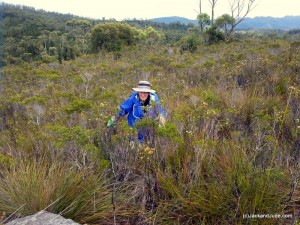 Look, we could go into the arduous chore of finding our route, the tunnelling up another hill of Bauera that took an entire day, then doing the same on another slope leading straight to that magical dashed line, but let’s cut to the climax. After three days of hard yakka, we opted for the Bauera tunnel that led to a shallow valley filled with thin growth that looked as if it magically would take us to the open plain near the headwaters of Big Eddy Creek. On a cloudy, chilly day, not so good for photos, but excellent for finding a route, the plains that had looked so clear and easy in the satellite photos proved to be mostly shoulder height tea tree of a variety that contain heaps of cup-shaped seedpods. Under them grow small tussocks of buttongrass. The two in combination make unsteady footing that must be taken slowly, tentatively putting a foot down before transferring full weight. We had lunch overlooking the Big Eddy creek then went off to look for the Hydro track. Geez, we went down into that creek, into the thick stuff again, found no running water, just a few tiny still pools, and we crisscrossed what should have been the dashed line shown on our map, but found neither Hydro sign nor their track.
Look, we could go into the arduous chore of finding our route, the tunnelling up another hill of Bauera that took an entire day, then doing the same on another slope leading straight to that magical dashed line, but let’s cut to the climax. After three days of hard yakka, we opted for the Bauera tunnel that led to a shallow valley filled with thin growth that looked as if it magically would take us to the open plain near the headwaters of Big Eddy Creek. On a cloudy, chilly day, not so good for photos, but excellent for finding a route, the plains that had looked so clear and easy in the satellite photos proved to be mostly shoulder height tea tree of a variety that contain heaps of cup-shaped seedpods. Under them grow small tussocks of buttongrass. The two in combination make unsteady footing that must be taken slowly, tentatively putting a foot down before transferring full weight. We had lunch overlooking the Big Eddy creek then went off to look for the Hydro track. Geez, we went down into that creek, into the thick stuff again, found no running water, just a few tiny still pools, and we crisscrossed what should have been the dashed line shown on our map, but found neither Hydro sign nor their track.
The next day being even cloudier, we took the whole day off. We needed time to stitch up our gloves and repair our torn pants. For relaxation, we read aloud to each other from Robinson Crusoe, ate lots of excellent food, and took an afternoon nap.
Early on our sixth morning, it was still heavily overcast, but we dressed to make our final charge to the vast open plain under the King Billy Range. But just before leaving, we heard distant voices. A bushman’s cooee brought a reply, and soon we had visitors, five of them to be exact. They were off other boats, had heard of our hobby, and on a whim followed our pink tapes. They were much younger than us and had taken just a bit over two hours to travel what had taken us months to locate and mark. Wow, we were stoked! And they were soaked because they brought the rain.
It continued to rain all our seventh day. Not heavily, just drizzle that creates that lovely misty look. And when that was replaced by the Southern Cross and pointers later in the evening, we went to bed filled with anticipation of a big day exploring a destination we’d work so hard to achieve.
Final Assault
Day eight began with a rare argument. Can’t remember what the issue was but it was an ominous start under a sky heavy with morning cloud. After we’d navigated the Bauera tunnel and came out in the shadow of the ranges we kissed and cuddled, our great love for the other nicely putting a spring to our steps.
We had two goals that day. One was to capture some of the magnificent beauty of the wild river mountains that are filled with so much colourful vegetation. The second was to find proof of the Hydro track. So we zoomed past our earlier lunch stop, skirted around the headwater dip of Big Eddy Creek, and headed into new territory.
Instead of being an absolute flat plain, this area is dotted with numerous small hills, some with clumps of slender trees, and some of these surrounded with dense bush. Between the King Billy Range and the plain are the headwaters of Cataract Creek flowing north, and the Sandstone Creek running south. Where the two headwaters begin there’s a land bridge joining the plains to the mountains, and it was to this point that we first headed. The going wasn’t easy, nor was it hard. We didn’t have to forge our way through the vegetation that varied from mostly waist height to open patches on the nutrient-poor ground, to shoulder height growth where conditions were better. We mostly just parted the growth with gloved hands, stepped tentatively forward, often over a clump of stunted buttongrass, and moved on repeating the process. We left very few pink tapes. No purpose in doing that as we could see all the landmarks and could go in just about any direction. But we did record our movements with GPS waypoints and had the luxury of transmitting our position via the Iridium satellite network using our fabulous Yellow Brick. We hope many of you followed our exploits live as they happened.
 On the higher hill separating the two headwaters from mountain and plain, we got some outstanding top of the world views. Providence shone down from a clear sky that allowed us to behold the majestic Franklin Gordon Wild River Valleys. Off to the furthest nor’ east we saw the lofty Elliot Range fall away into the Franklin River valley, where it enters the massive Gordon River valley that spanned our entire view. To our south, we followed the Sandstone Creek to where it joins the Rocky Sprent. We could even see where the Hydro camp must be and just a titch south of it, still on the Gordon, the Morrison’s Sandstone Camp where we had filmed the remains of the stables, meat safe, and moss-covered Blundstone boot.
On the higher hill separating the two headwaters from mountain and plain, we got some outstanding top of the world views. Providence shone down from a clear sky that allowed us to behold the majestic Franklin Gordon Wild River Valleys. Off to the furthest nor’ east we saw the lofty Elliot Range fall away into the Franklin River valley, where it enters the massive Gordon River valley that spanned our entire view. To our south, we followed the Sandstone Creek to where it joins the Rocky Sprent. We could even see where the Hydro camp must be and just a titch south of it, still on the Gordon, the Morrison’s Sandstone Camp where we had filmed the remains of the stables, meat safe, and moss-covered Blundstone boot.
Those Piners would have had a tough life out here in the cold, wet wilds, but what a glorious magical place to work. It’s a Godly place where souls are in direct contact with the creator. A simple life, a fulfilling one, one counting on your mates and they relying on you. Those images and thoughts keep us wondering where the world is heading now.
Over lunch somewhat spoiled by pesky March Flies, we discussed coming back one day with our camp so that we can explore further and maybe reach the Hydro or Morrison’s Sandstone camp overland. Water would be the problem. The only water we’d seen was at Banksia Camp. But we imagined finding some in the Sandstone Creek.
We planned a return to our camp that would take us to the dashed line shown on our map, hoping we’d find a remanent of the old historic track. So we followed a route to the dashed line crossing a meridian.
A Great Find
It was three o’clock, and we’d been underway six hours when crossing the meridian led us around a second dry creek, even further south away from our camp, deeper into the plains. Ahead lay a patch of grey boulders sprouting out the growth, above them a hilltop grew thicker. At a time when we wanted to be heading home for a comfy change out of boots, difficult country loomed ahead. Small trees thickened by undergrowth covered the hilltop, and I was about to divert around it when a strange glimpse of something odd caught my eye. I looked again but saw nothing unusual amongst the stems and bushy heads and started to turn away, when again something strange, something unnatural stopped me. Rocking back and forth, I gazed past the growth and saw a regular shape amongst it.
“Yahoo!” I sang out, alarming Judith. “There’s a Hydro sign.”
Rushing forward, I prayed I’d not just imagined it. Nope, I hadn’t. Standing tall on a metal stake stood a yellow metal diamond with that familiar red dot in its centre. Geez, how long had that thing been standing out here? Thirty years, forty? Crikey it could have been here fifty years. We’d found proof of the Hydro Track. This was the route first cut by Charles Gould more than a hundred fifty years ago. Of course, we put a couple of our pink tapes on the sign, made a waypoint, and sent off a Yellowbrick position so that all could share in our excitement. Then we headed home. A long trudge lay ahead. But the delight of fulfilling a dream made light work of our task. In fact, the ever beautiful scenery seemed to grow in magnitude as we both savoured the moment.
Funny, we were still on a high, trudging up another hill through waist height growth when Judith sudden yelped, “There’s another one!” And following her outstretched arm, I saw the second diamond ahead on the hilltop, black and backlit by the now weakening sun.
It was Judith’s turn to tie the pink tape on this relic. Her turn also to pose for photos. Beautiful ones they are with the Elliot Range and Franklin River in the far distance.
Suffice to say we got home in a timely fashion, a ten-hour day, our feet sore but no broken bones, no skinned shins—just plenty of beautiful photos and glorious memories. And a few ideas of where to go next time.
Fulfilment
Packing up and walking out the next day turned out to be another marvellous experience. What can we say? The work we had completed to give ourselves the opportunity to experience such greatness really sank in. And the walk down The Huon Way, now cleared by others inspired by our work, is a magical stroll through one of Tasmania’s most breathtaking forests. Treat yourself. It’s easy and safe, walk The Huon Way from Sir John Falls past Camp Twin Pines to the end of the shoe road. Now, wouldn’t it be wonderful if Parks were to put up a few of those informative signs describing the various species and some of the history?

